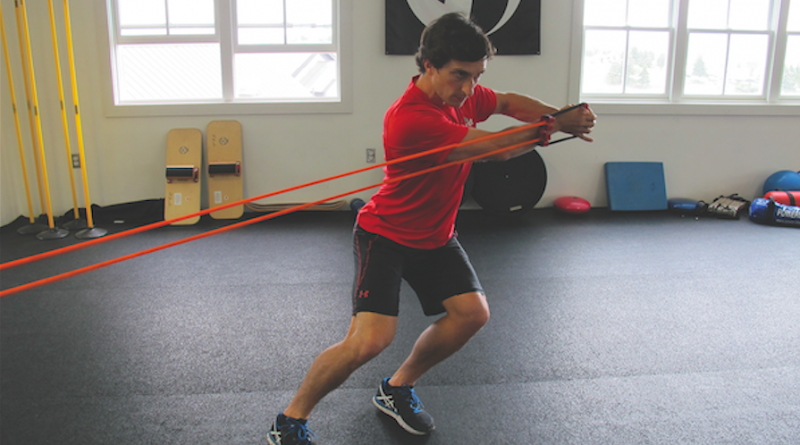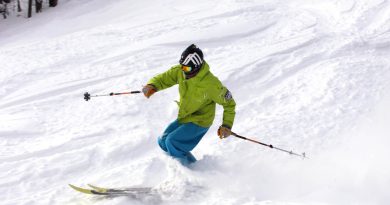Training right with iSport
There’s a reason why World Cup skiers, Olympic athletes and NFL stars head to Killington’s iSport to train each year. It’s not just to get in shape, it’s to learn to train right.
By Peggy Shinn
Fifteen stomach crunches. That seemed easy enough.
Except, I had just spent an hour doing medicine ball rollups, sideways pulls, and a half dozen other challenge stations on a circuit designed to whip the middle-aged into shape. Intermixed were weighted lunges and squats named after former Eastern Bloc countries, fast-footed drills through an agility ladder, lateral jumps over mini-hurdles, and one-footed balance drills on a BOSU ball (short for “both sides utilized”).
It wasn’t just the intensity that was hard, it was the way we performed each drill. Better to do one perfect lunge—shin forward, heel down, knee stable, thigh parallel to the floor—than 10 wobbly, off-kilter ones.
Pain aside, I was happy to be here in Killington at iSport, the sports medicine branch of Vermont Orthopaedic Clinic, for part of a five-week pre-season advanced ski training class. None of us in the class had been injured—at least not recently. My goal was to not only to get stronger so I could perform better on the slopes but also to prevent future injury.
The movements we were doing—and don’t call them exercises —are the same ones that iSport’s founder Knowles Knowles and his protégé White have developed for a who’s who of Olympic gold medalists, and NFL, NBA, and NHL stars. They include Vermonters Hannah Teter (Olympic gold and silver in snowboarding), Hannah Kearney (Olympic gold and bronze in moguls), and Lea Davison (world championship bronze in mountain biking). Signed posters of these athletes—and others—dot the hallway at iSport.
As for the stars from more mainstream sports, White won’t divulge names. But he did chuckle as he remembered the NBA player who arrived in Killington in the dark and feared he would be eaten by a bear.
Bill Knowles, the former head trainer and performance director at Burke Mountain Academy founded iSport ten years ago. He had become so effective at helping academy skiers recondition after knee injuries that skiers around the world flocked to him. At iSport, he aimed to offer the same reconditioning and performance training to athletes across the board — and not only those on their way to the Super Bowl or Olympic Games. Knowles recently moved to the Philadelphia area to work with Philadelphia Eagles quarterback Sam Bradford and others. But he handed the reigns to his protégé, White, to carry on.
As White says, “You don’t have to be a big name to train here. I just like seeing people get better.” ISport’s movements are designed to make people stronger and fitter by focusing on qualify over quantity. In other words, it’s not what you do—how fast you move or how much weight you lift. It’s how you do it.
As an example, White describes what happened when he first met Knowles in 2008. The elder trainer gave a talk at Castleton State College (now University), where White was a senior. Knowles asked for a volunteer to demonstrate how to properly step up on a box. Simple enough, thought White. So he raised his hand.
Except instead of just stepping up on the box as if climbing the stairs, Knowles showed White, in infinitesimal movement by infinitesimal movement, how to properly strengthen the glutes, quads, and hamstrings by the simple motion of stepping up.
“It was: ‘Drive your heel into the ground! Get your quad, hamstring, and glutes firing together. Don’t step up yet, keep pressuring down, then slowly shift your weight over into the step. Drive down into the step, control yourself up, control yourself down, step off,’” explained White.
No knee caving inward, no body leaning forward, no cheating by using the calf muscle.
“If you let bad technique go, it’s going to become worse technique,” he added.
Bad technique, or simply doing whatever it takes to accomplish an exercise, means weaknesses get weaker, strengths get stronger, and the imbalance can lead to injury down the road.
With the focus on balanced movements, the iSport facility above the Killington Medical Clinic is not filled with weight machines, treadmills, or lab equipment. Instead, it’s one big room that looks, at first glance, like an indoor playground.
The walls are lined with racks of brightly colored balls — fit balls, weighted medicine balls, and blue BOSU balls — as well as boxes of colorful stretchy bands, tall orange “slalom” poles, blue and green balancing poles, racks with webbing and jump ropes draped over them, and the Pacer, a blue cube that’s made of foam for jumping (but with no rebound). Fun, right?
Then there’s the big blue rope, thick enough and long enough to hold a large boat at anchor. To keep it moving continually along its entire length takes muscles that you didn’t even know you had — and lung-fulls of air.
“The NFL guys like it,” said White with a smile.
But women with feeble arms? Not so much.
Everyone works out with the same equipment though, doing the same movements, whether you are a high school soccer player recovering from shin splints, a World Cup alpine skier trying to step on the podium again after a torn Achilles tendon, an NHL Stanley Cup player with a trick shoulder, or a middle-aged mom hoping to keep up with her ski-racing daughter on the slopes.
As for those 15 crunches, I did five easily. Until White reminded me to keep my chin pointed toward the ceiling and elbows out. My abs were soon marinating in lactic acid.
And don’t ask me to haul on that heavy rope.
See also: 6 Steps to Train like a Pro this Winter




Pingback: Vermont Sports Magazine | Your Guide to the Outdoors in Northern New England